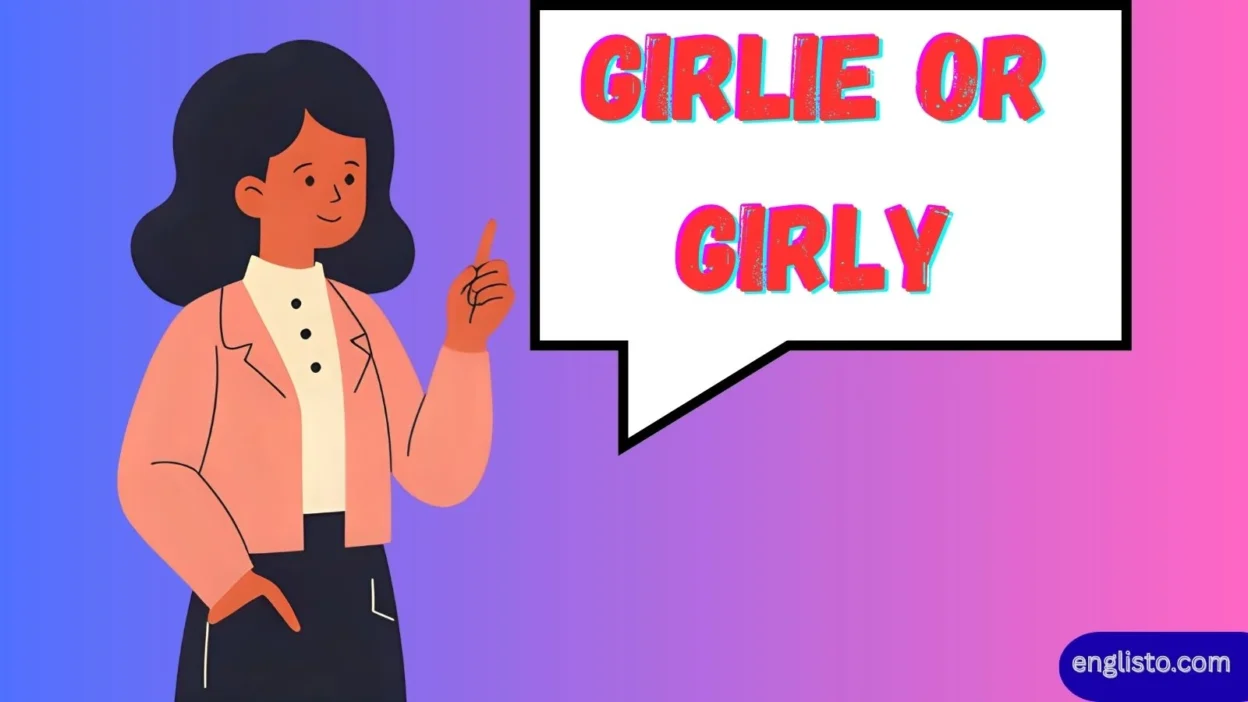Language is full of subtle choices that can change how we express ourselves. One such choice comes up often in casual conversation, writing, and even fashion magazines: should you say Girlie or Girly?
At first glance, both words look almost identical. They’re both associated with girls, femininity, playful tones, pastel colors, floral prints, sparkly accessories, and a youthful vibe. Yet the nuances, history, and connotations of “girlie” and “girly” reveal fascinating differences.
This article dives deep into their origins, meanings, cultural associations, and real-world usage, helping you decide when to use one over the other.
Understanding the Basics of “Girlie” vs. “Girly”
When deciding between “girlie” and “girly,” it helps to look at their dictionary definitions and usage in everyday English.
| Word | Part of Speech | Definition (Modern) | Tone | Example Sentence |
| Girly | Adjective | Characteristic of, associated with, or appropriate to girls or young women. | Neutral to playful | “She decorated her room in a girly style with pastel colors and floral prints.” |
| Girlie | Adjective/Noun | (Adj.) Often used for playful, light, or nostalgic femininity. (Noun) Sometimes refers to women featured in magazines, often scantily clad. | Playful to sometimes offensive | “They had a fun girlie weekend with spa visits and shopping.” / “Old magazines often had girlie pictures.” |
Key takeaway:
- Girly = a safe, neutral choice in describing feminine qualities, style, or tone.
- Girlie = carries both lighthearted and historically sexualized undertones, depending on context.
Read More: Excess or Excessive: Understanding the Difference and Using Them Correctly
Historical Roots and Etymology
The story of these words stretches back centuries:
- The word “girl” itself comes from Middle English gerle or gor, recorded in the 15th century. Back then, it could refer to children of either gender.
- The suffix “-y” has long been used in English to form adjectives (e.g., “snowy,” “windy”), so “girly” naturally developed as “like a girl.”
- “Girlie” appeared later, around the 1940s–50s, in publications and magazines. At that time, it was used both innocently (to describe young girls or playful behavior) and in derogatory or sexualized ways—especially in so-called “girlie magazines.”
Thus, while girly evolved steadily as a descriptive adjective, girlie took on layered, sometimes controversial meanings.
Everyday Usage in Modern English
In 2023 and beyond, language is more fluid. People often use both words interchangeably in casual speech, but subtle preferences remain:
- Girly is more common when describing:
- Style & Fashion: floral dresses, pastel outfits, handbags.
- Decor: pink bedrooms, glittery notebooks, tidy vanity setups.
- Tone: a playful or youthful vibe, but not sexualized.
- Style & Fashion: floral dresses, pastel outfits, handbags.
- Girlie is more often seen in:
- Colloquial speech: “Let’s have a girlie chat over coffee.”
- Nostalgic contexts: retro magazines, pin-up posters, or “girlie shows.”
- Negative connotations: when used sarcastically or to belittle (e.g., “That’s a bit girlie for you to wear.”).
- Colloquial speech: “Let’s have a girlie chat over coffee.”
Nuances and Tone
The difference between the two often comes down to tone and intention:
- Girly sounds innocent, lighthearted, and modern. It fits well in everyday language without raising eyebrows.
- Girlie can be affectionate when used among friends (“girlie weekend”), but may sound outdated or even offensive in formal contexts.
Example:
- “Her handwriting is very girly—full of hearts and flowers.” (Playful, descriptive)
- “The magazine was full of girlie pictures.” (Sexualized, dated)
Social and Cultural Associations
Words don’t live in isolation; they carry cultural baggage:
- In Western cultures, “girly” often emphasizes innocence, youth, and fun. It’s tied to hobbies like shopping, spa days, makeup, and fashion.
- Girlie, however, has been tied historically to magazines, posters, and entertainment that portrayed women as objects, especially during the 1940s–60s.
This difference explains why some feminists critique the word “girlie” for its patronizing undertones, while others reclaim it in a playful, empowering way.
Girly vs. Girlie in Fashion and Lifestyle
Fashion writers and lifestyle bloggers often choose carefully between the two:
- Girly Style: Refers to clothing and aesthetics—think pastel sweaters, floral skirts, sneakers with bows, perfumes with light floral scents.
- Girlie Style: Suggests a retro, playful, or cheeky vibe, sometimes bordering on burlesque or pin-up aesthetics.
| Style Element | “Girly” | “Girlie” |
| Dresses | Floral, soft, everyday wear | Vintage pin-up, glittery party outfits |
| Colors | Pastels, whites, light pinks | Bold reds, sparkles, neon with flair |
| Accessories | Handbags, bows, sneakers | Costume jewelry, glitter, feathers |
| Tone | Innocent, lighthearted | Playful, cheeky, sometimes risqué |
Grammar and Pronunciation Notes
- Spelling: Both are correct, but “girly” is more standard in modern English.
- Pronunciation:
- Girly → /ˈgɚli/ (gur-lee)
- Girlie → also /ˈgɚli/ (identical sound)
- Girly → /ˈgɚli/ (gur-lee)
Because they sound the same, writers and speakers must rely on context to convey meaning.
Related Words and Synonyms
When describing feminine qualities, you might also use:
| Word | Shade of Meaning |
| Feminine | Neutral, broad term for female qualities. |
| Girlish | Youthful, innocent, often linked to childhood. |
| Womanly | Mature, dignified, traditionally feminine. |
| Ladylike | Polite, refined, mannered. |
| Juvenile | Youthful, but sometimes negative. |
| Boyish (opposite) | Playful, tomboyish, not stereotypically feminine. |
Context Matters: When to Choose Each
- Writing for a fashion magazine? → Use girly.
- Talking with close friends in a playful way? → Either works, but “girlie” feels more casual.
- Academic or professional writing? → Stick to girly—it’s more neutral and widely accepted.
- Referring to magazines or history? → Use girlie, since that’s the historically correct label.
Real-Life Examples
- Girly sentence: “Her outfit was so girly, with pink sneakers and a matching bow.”
- Girlie sentence: “The 1950s saw a rise in girlie magazines that shaped cultural views on women.”
Evolution and Modern Changes
Today, younger generations (Gen Z and Alpha) tend to:
- Use girly more often in positive, lighthearted contexts.
- Avoid girlie unless referencing something retro, ironic, or playful among friends.
This shift reflects broader changes in feminist discourse, gender identity, and respect for women’s representation in media.
FAQs
What’s the main difference between “girly” and “girlie”?
“Girly” is neutral and modern, describing feminine qualities. “Girlie” can be playful but also carries outdated or sexualized undertones.
Is “girlie” offensive?
It depends on context. Among friends, it can be affectionate. In formal writing or when used to describe women in general, it may sound patronizing.
Can I use them interchangeably?
Sometimes, but “girly” is the safer and more accepted choice today.
Which one do dictionaries prefer?
Most modern dictionaries list girly as the standard form. Girlie appears, but often with notes about its dated or offensive use.
How do I know which to choose in writing?
Ask yourself: Am I aiming for playful, casual speech? Then “girlie” may work. For professional, descriptive, or fashion contexts, stick with “girly.”
Conclusion
The words “girly” and “girlie” may look and sound the same, but they carry different shades of meaning. Girly is the modern, neutral, and widely accepted adjective for describing feminine style, behavior, or vibe. Girlie, meanwhile, is layered with nostalgia, playfulness, and sometimes problematic undertones from its history in magazines and media.
By paying attention to context, audience, and tone, you can choose the right word and communicate with precision, nuance, and respect.



